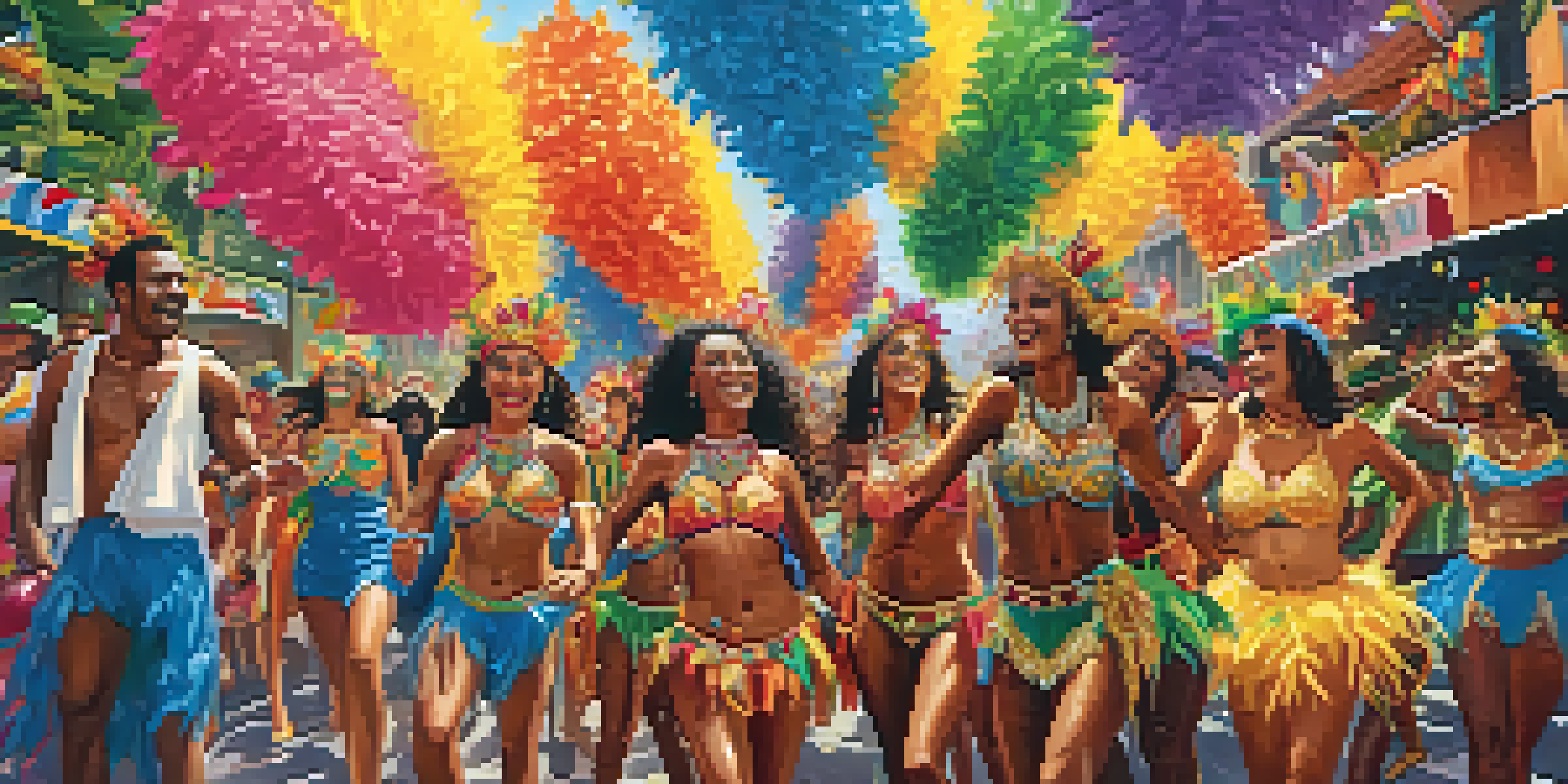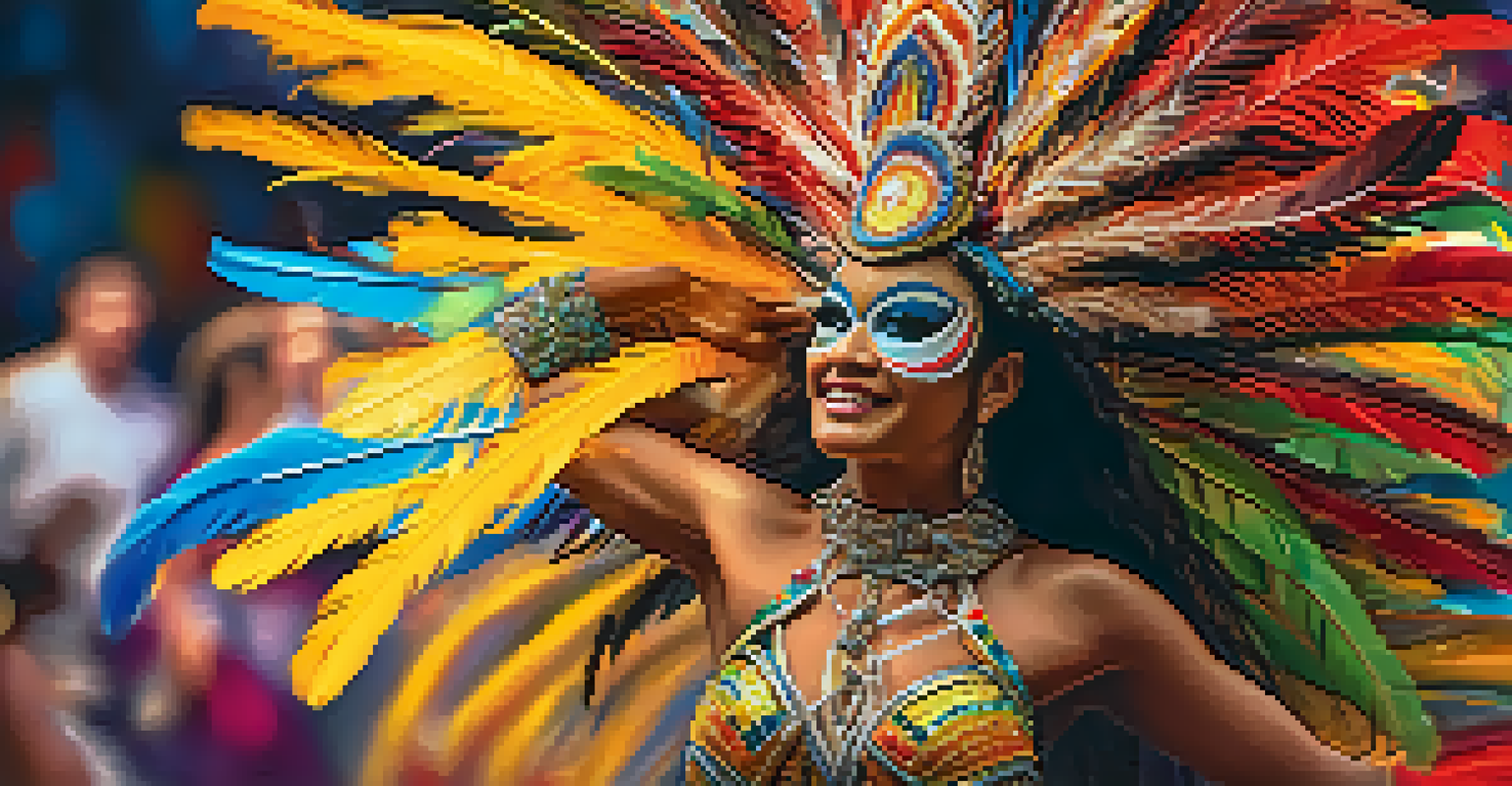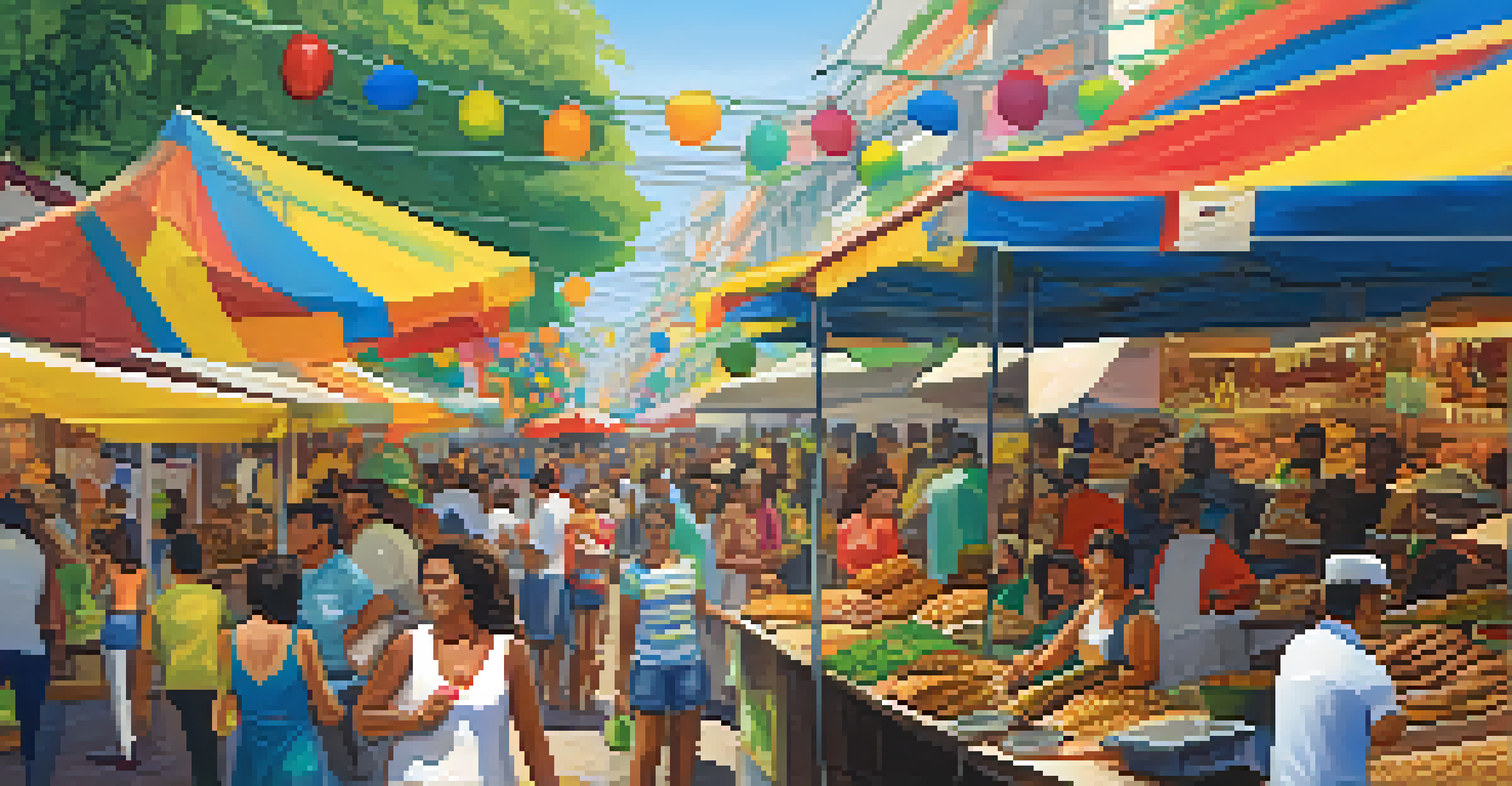Exploring the Colorful Carnival of Rio: A Celebration of Diversity

The Heartbeat of Rio: Carnival's Rich History
Rio's Carnival, often hailed as the world's largest party, has deep roots in Brazilian culture. It began in the 18th century as a European-style festival, but over time, it has evolved into a uniquely Brazilian celebration. Each year, the streets transform into a vibrant display of color, music, and dance, showcasing the rich history of this diverse nation.
Carnival is a celebration of life, a moment where we can all come together and embrace our differences.
The festival's origins can be traced back to Portuguese colonization, where the tradition of masquerade balls and street festivities took hold. However, it wasn't until the early 20th century that samba, an Afro-Brazilian musical genre, became integral to the celebrations. Today, samba schools compete in elaborate parades, bringing together communities and showcasing their cultural heritage.
Carnival is more than just a party; it's a reflection of Brazil's diversity and resilience. From the rhythms of samba to the intricate costumes, every aspect of the event tells a story of unity and pride in cultural identity, making it a true celebration of life.
The Spectacle of Samba Schools
At the heart of Rio's Carnival are the samba schools, which serve as the backbone of the parade. These community organizations dedicate the entire year to prepare for the event, from creating dazzling floats to choreographing intricate dance routines. Each school tells a unique story through their performances, often inspired by social issues, folklore, or historical events.

As the samba schools compete for the prestigious title of champion, they transform the Sambadrome into a dazzling arena of colors and sounds. Thousands of participants, dressed in elaborate costumes, dance to the infectious beats of live samba music, captivating audiences with their energy and creativity. The atmosphere is electric, with cheers and applause echoing throughout.
Carnival Celebrates Cultural Diversity
Rio's Carnival is a vibrant fusion of African, Indigenous, and European traditions, showcasing Brazil's rich cultural identity.
This competitive spirit not only highlights the artistic talents of each school but also fosters a strong sense of community. Members come together, regardless of background, to celebrate their shared culture and contribute to a collective identity that transcends individual differences.
Diverse Cultural Influences in Carnival
One of the most beautiful aspects of Rio's Carnival is its celebration of diversity. The event draws on a rich tapestry of cultural influences, including African, Indigenous, and European traditions. This blend is evident in the music, dance, and even the food that fills the streets during the festivities.
The beauty of Carnival lies in its ability to unite people from all walks of life, creating a tapestry of culture and joy.
For instance, the rhythms of samba are deeply rooted in African heritage, while the lively street parties reflect the communal spirit of Indigenous cultures. European influences can be seen in the elaborate costumes and the festive atmosphere reminiscent of traditional masquerade balls. Together, these elements create a vibrant mosaic that represents Brazil's multifaceted identity.
As people from all walks of life come together to celebrate, Carnival serves as a reminder of the importance of inclusivity and acceptance. It showcases how different cultures can coexist harmoniously, creating a powerful narrative of unity in diversity that resonates with both locals and visitors alike.
Street Parties: The Soul of Carnival
While the parades in the Sambadrome are spectacular, the street parties, known as 'blocos', capture the true essence of Rio's Carnival. These informal gatherings take place throughout the city and invite everyone to join in the festivities, regardless of age or background. Each bloco has its own unique theme, music, and vibe, making them a cornerstone of the celebration.
As you stroll through the streets, you'll find blocos filled with joyful revelers dancing to samba, pagode, and other infectious rhythms. The atmosphere is one of pure joy, with people laughing, singing, and celebrating together. It's a beautiful sight to see groups of friends, families, and strangers coming together to create lasting memories.
Samba Schools Drive the Festivities
Samba schools are the heart of Carnival, dedicating a year to prepare elaborate performances that reflect community stories and social issues.
Participating in a bloco is like being part of a massive, spontaneous celebration that embodies the spirit of Carnival. It's a testament to the power of music and dance to bring people together, reminding us that joy knows no boundaries.
The Role of Food in Carnival Celebrations
No celebration is complete without delicious food, and Rio's Carnival is no exception. Street vendors line the streets, offering a mouthwatering array of traditional Brazilian dishes that keep the energy high and the spirits lifted. From savory snacks like 'coxinhas' (chicken croquettes) to sweet treats like 'brigadeiros' (chocolate truffles), there's something for every palate.
Food plays a vital role in the Carnival experience, as it brings people together to share in the festivities. Whether it's grabbing a quick bite between parades or enjoying a leisurely meal with friends, these culinary delights enhance the sense of community that defines the celebration. Sharing a meal is a universal way to connect, and during Carnival, it becomes a joyful ritual.
Moreover, many of the dishes served during Carnival have historical significance, reflecting the diverse cultural influences that shape Brazilian cuisine. By indulging in these traditional foods, revelers not only satisfy their appetites but also partake in a rich cultural heritage, making the experience even more meaningful.
Safety and Community Spirit During Carnival
As thrilling as Carnival can be, safety is a top priority for both participants and organizers. In recent years, there has been a concerted effort to enhance security measures, ensuring that everyone can enjoy the festivities without fear. Local authorities work closely with community leaders to create a safe and welcoming environment for all.
Community spirit plays a crucial role in maintaining safety during Carnival. Neighbors look out for one another, and many revelers participate in organized groups to foster a sense of camaraderie. This collective responsibility helps to create an atmosphere of mutual respect, where everyone can relax and enjoy the celebration.
Street Parties Capture Carnival's Spirit
The informal street parties, or 'blocos', embody the joyful essence of Carnival, inviting everyone to celebrate together regardless of background.
Carnival is ultimately about coming together as one, and this sense of unity extends to ensuring that everyone feels safe and included. By prioritizing safety and community spirit, Rio's Carnival continues to thrive as a beloved celebration that honors diversity and joy.
The Global Impact of Rio's Carnival
Rio's Carnival is not just a local event; it has gained international recognition and attracts millions of visitors from around the globe. This influx of tourists contributes significantly to the local economy, boosting businesses ranging from hotels to restaurants. The celebration has become a symbol of Brazil's vibrant culture and hospitality.
Moreover, the global attention on Carnival highlights the importance of cultural exchange. Visitors have the opportunity to experience firsthand the rich traditions of Brazil, while locals embrace the chance to share their customs and stories. This interaction fosters a deeper understanding and appreciation of the diverse cultures represented during the celebration.

As Carnival continues to grow in popularity, it reinforces the idea that cultural celebrations have the power to unite people from different backgrounds. In a world that often feels divided, events like Rio's Carnival remind us of the beauty of diversity and the shared joy of coming together in celebration.